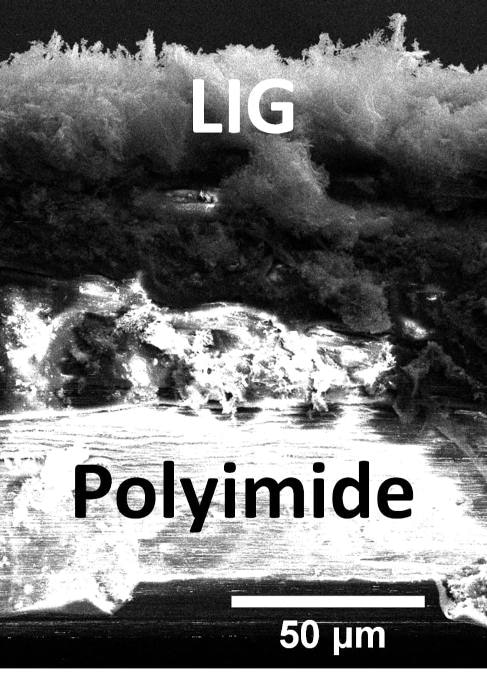Jun 3 2019
Wearable devices that yield energy from motion are not a new concept, but a material developed at Rice University may make them more realistic.
 An electron microscope image shows a cross-section of a laser-induced graphene and polyimide composite created at Rice University for use as a triboelectric nanogenerator. The devices are able to turn movement into energy that can then be stored for later use. (Image credit: Tour Group)
An electron microscope image shows a cross-section of a laser-induced graphene and polyimide composite created at Rice University for use as a triboelectric nanogenerator. The devices are able to turn movement into energy that can then be stored for later use. (Image credit: Tour Group)
The Rice lab of chemist James Tour has modified laser-induced graphene (LIG) into small, metal-free devices that produce electricity. Similar to rubbing a balloon on hair, making LIG composites to contact with other surfaces generates static electricity that can be employed to power up devices.
Thanks to the triboelectric effect, the materials harvest a charge via contact. When they are joined and then separated, surface charges accumulate that can be channeled toward power generation.
As part of the experiments, the scientists linked a folded strip of LIG to a string of light-emitting diodes and discovered that hitting the strip generated adequate energy to make them flash. A bigger piece of LIG embedded within a flip-flop allows a wearer to produce energy with every step, since the repeated contact of graphene composite with skin generated a current to charge a small capacitor.
This could be a way to recharge small devices just by using the excess energy of heel strikes during walking, or swinging arm movements against the torso.
James Tour, Chemist, Rice Lab
The project is explained in the American Chemical Society journal ACS Nano.
LIG, a graphene foam, is made by heating chemicals on the surface of a polymer or other material with a laser, leaving only interconnected flakes of two-dimensional carbon. Initially, the lab produced LIG on common polyimide, but extended the method to food, plants, wood, and treated paper.
The lab converted cork, polyimide, and other materials into LIG electrodes to observe how well they generated energy and endured wear and tear. They received the best outcomes from materials on the opposite ends of the triboelectric series, which measures their potential to produce static charge by contact electrification.
In the folding configuration, LIG from the tribo-negative polyimide was applied with a protecting coating of polyurethane, which also acted as a tribo-positive material. When the electrodes were brought into contact with each other, electrons got transferred to the polyimide from the polyurethane. Successive contact and separation propelled charges that could be stored through an external circuit to rebalance the accumulated static charge. The folding LIG produced about 1 kV, and remained stable after 5,000 bending cycles.
The best configuration, with electrodes of the polyimide-LIG composite and aluminum, generated voltages greater than 3.5 kV with a peak power of over 8 mW.
The nanogenerator embedded within a flip-flop was able to store 0.22 millijoules of electrical energy on a capacitor after a 1-kilometer walk. This rate of energy storage is enough to power wearable sensors and electronics with human movement.
Michael Stanford, Study Lead Author, Postdoctoral Researcher, Rice University
Rice graduate students Yieu Chyan and Zhe Wang and undergraduate students John Li and Winston Wang are the co-authors of the paper. Tour is the T.T. and W.F. Chao Chair in Chemistry as well as a professor of computer science and of materials science and nanoengineering at Rice.
The study was supported by the Air Force Office of Scientific Research.
Triboelectric generator powers LEDs
Lab video demonstrates that repeatedly hitting a folded triboelectric generator produced enough energy to power a series of attached light-emitting diodes. The test showed how generators based on laser-induced graphene could be used to power wearable sensors and electronics with human movement. (Video credit: Tour Group)